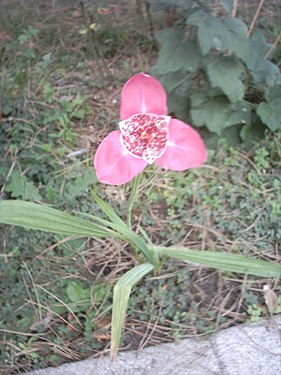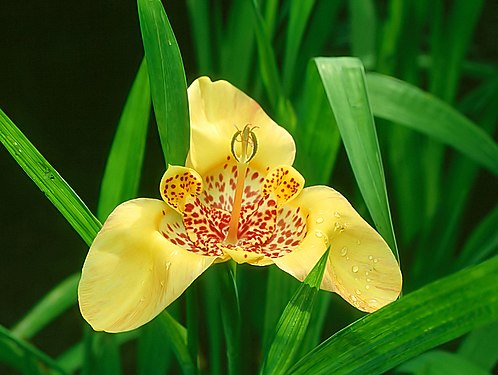Difference between revisions of "Tigridia"
| Line 4: | Line 4: | ||
|common_name=Jockey's cap, Tiger flower | |common_name=Jockey's cap, Tiger flower | ||
|name_ref=Flora - A Gardener's Encyclopedia | |name_ref=Flora - A Gardener's Encyclopedia | ||
| + | |habit=bulbous | ||
| + | |lifespan=perennial | ||
| + | |exposure=sun | ||
| + | |features=flowers | ||
|Temp Metric=°F | |Temp Metric=°F | ||
| − | + | |image=Tigrida pavonia.JPG | |
| − | |image= | ||
|image_width=240 | |image_width=240 | ||
}} | }} | ||
| − | + | '''Tigridia''' ({{pron-en|taɪˈɡrɪdiə}}),<ref>''Sunset Western Garden Book,'' 1995:606–607</ref> the '''tiger-flowers''' or '''shell flowers''', is a genus of [[bulb]]ous or [[corm]]ous plants, belonging to the family [[Iridaceae]]. They have large showy [[flower]]s and one species, ''[[Tigridia pavonia]]'', is often cultivated for this. The approximately thirty five species in this family grow in the [[Western Hemisphere]], from [[Mexico]] to [[Chile]]. The tigridia flower is short lived, each often blooming for only one day, but often several flowers will bloom from the same stalk. Usually they are dormant during the winter dry-season. Its roots are edible and was eaten by the [[Aztec]]s of [[Mexico]] who called it ''cacomitl'' and its flower ''ocēlōxōchitl'' "Jaguar flower". The genus name means "tiger-like" and alludes to the coloration and spotting of the flowers of the [[type species]] ''Tigridia pavonia''.<ref name=Goldblatt2008>{{cite book |author=Manning, John; Goldblatt, Peter |title=The Iris Family: Natural History & Classification |publisher=Timber Press |location=Portland, Oregon|pages=253–56 |year=2008|isbn=0-88192-897-6}}</ref> | |
| − | + | ||
| − | |||
| − | | | ||
| − | |||
| − | |||
| − | |||
| − | |||
| − | |||
| − | |||
| − | |||
| − | |||
| − | |||
| − | |||
| − | |||
| − | |||
| − | |||
| − | |||
| − | |||
| − | |||
| − | | | ||
| − | | | ||
| − | | | ||
| − | | | ||
| − | | | ||
| − | | | ||
| − | }} | ||
{{Inc| | {{Inc| | ||
Tigridia (tiger-like, referring to the peculiarly marked flowers). Iridaceae. Bulbous plants, grown in the greenhouse and also making very showy summer- blooming subjects. | Tigridia (tiger-like, referring to the peculiarly marked flowers). Iridaceae. Bulbous plants, grown in the greenhouse and also making very showy summer- blooming subjects. | ||
| Line 82: | Line 60: | ||
==Gallery== | ==Gallery== | ||
| − | + | <gallery perrow=5> | |
| − | + | File:Palenque.jpg | |
| − | + | File:Tigrida pavonia.JPG | |
| − | + | File:Tigrida pavonia.jpg | |
| − | + | File:Tigrida-pavonia-flower.jpg | |
| − | + | File:Tigridia pavonia Duerkheim.jpg | |
| + | File:Tigridia pavonia.jpg | ||
| + | File:Tigridia-pavonia-habitus.jpg | ||
| + | File:Unbekannte Blume-2.JPG | ||
</gallery> | </gallery> | ||
| Line 99: | Line 80: | ||
*{{wplink}} | *{{wplink}} | ||
| − | + | __NOTOC__ | |
| − | |||
| − | |||
| − | |||
Latest revision as of 19:31, 27 April 2010
| Habit | bulbous
| |
|---|---|---|
| Lifespan: | ⌛ | perennial |
| Exposure: | ☼ | sun |
|---|---|---|
| Features: | ✓ | flowers |
|
Tigridia > |
Tigridia (pronounced /taɪˈɡrɪdiə/),[1] the tiger-flowers or shell flowers, is a genus of bulbous or cormous plants, belonging to the family Iridaceae. They have large showy flowers and one species, Tigridia pavonia, is often cultivated for this. The approximately thirty five species in this family grow in the Western Hemisphere, from Mexico to Chile. The tigridia flower is short lived, each often blooming for only one day, but often several flowers will bloom from the same stalk. Usually they are dormant during the winter dry-season. Its roots are edible and was eaten by the Aztecs of Mexico who called it cacomitl and its flower ocēlōxōchitl "Jaguar flower". The genus name means "tiger-like" and alludes to the coloration and spotting of the flowers of the type species Tigridia pavonia.[2]
Read about Tigridia in the Standard Cyclopedia of Horticulture
|
|---|
|
Tigridia (tiger-like, referring to the peculiarly marked flowers). Iridaceae. Bulbous plants, grown in the greenhouse and also making very showy summer- blooming subjects. Bulbs tunicated: st. erect, mostly unbranched, 1- 2 1/2 ft. tall, with a few narrow plicate lvs. at the base and 2 or 3 smaller ones higher up: spathes 1 or 2, leaf-like, each bearing 1 or few blossoms: fls. in shades of yellow, orange or purplish, variously spotted, often very showy; perianth wide-spreading, with no tube, the segms. 6, in 2 dissimilar series, connivent into a broad cup at the base; stamens 3, the filaments united into a long cylindrical tube including the style; pistil with 3-loculed ovary, long style with 3 2-parted branches.— About 13 species from Mex., Cent. Amer., Peru, and Chile. T. Pavonia, from S. Mex., was in cult. in Eu. in the 16th century. L'Obel described it in 1576. The younger Linnaeus referred it to the genus Ferraria, and some of the tigridias are yet cult. under that name. Ferraria, however, is a S. African genus, and all the parts of the perianth are nearly equal. T. Pavonia is cult. in many forms, and is the only common species in gardens. The fls. of all tigridias are fugitive, lasting only for a day. Tigridias are tender "bulbs" requiring the treatment given gladiolus. Plant in well-prepared soil when settled weather comes, 2 to 3 inches deep and 4 to 8 inches apart. The principal blooming period is July and August. Allow the corms to remain in the ground until danger of frost approaches, then store in a dry place where dahlias or gladioli will keep. See that the corms are dry before being placed in storage. Propagation is by cormels and seeds. The best colors are secured in warm weather. T. aurea, Hort., is Cypella plumbea.—T. coelestis, Hort., is Cypella plumbea.—T. Houttei, Roezl, is Hydrotaenia Van Houttei.—T. Maleagris, Hort., is also a Hydrotaenia (H. Meleagris, Lindl.), but is not in the American trade. B.R. 28:39.—T. violacea, Schiede. & Schlecht. One of the Beatonia section: slender, narrow-lvd.: fls. 2 in. across, violet, spotted at the base; inner segms. small, cusp-pointed. Mex. B.M. 7356. H.U. 3, p. 301. Other kinds of Tigrida are likely to appear in cult. CH
|
Cultivation
- Do you have cultivation info on this plant? Edit this section!
Propagation
- Do you have propagation info on this plant? Edit this section!
Pests and diseases
- Do you have pest and disease info on this plant? Edit this section!
Species
Species of Tigridiawp:
- Tigridia chiapensis
- Tigridia dugesii
- Tigridia durangense
- Tigridia ehrenbergii
- Tigridia hallbergii
- Tigridia mexicana
- Tigridia pavonia
- Tigridia multiflora
- Tigridia orthantha
- Tigridia vanhouttei
- Tigridia violacea
- Tigridia flammea
- Tigridia immaculata
- Tigridia inusitata
- Tigridia philippiana
- Tigridia huajuapanensis
- Tigridia pasiflora
- Tigridia meleagris
- Tigridia molseediana
- Tigridia alpestris
- Tigridia seleriana
- Tigridia bicolor
Gallery
References
- Standard Cyclopedia of Horticulture, by L. H. Bailey, MacMillan Co., 1963
External links
- w:Tigridia. Some of the material on this page may be from Wikipedia, under the Creative Commons license.
- Tigridia QR Code (Size 50, 100, 200, 500)
- ↑ Sunset Western Garden Book, 1995:606–607
- ↑ Manning, John; Goldblatt, Peter (2008). The Iris Family: Natural History & Classification. Portland, Oregon: Timber Press. pp. 253–56. ISBN 0-88192-897-6.








